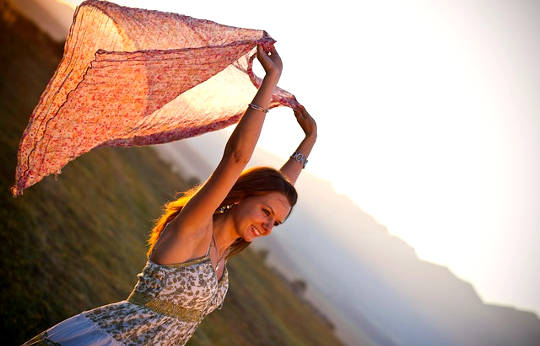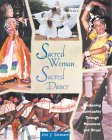
Dance as liturgy or ritual has always been a way to honor the sacred, the mystery, turning into the spiral of life and the universal, the ever-present flow of the Divine force. It has profound implications for healing, psychotherapy, spiritual growth, and the full unfolding of human potential.
Sacred dance can be done by anyone and in any mode. It may be part of an ancient tradition or may emanate in the moment. It can range from simple walking steps in a circle to elaborately costumed processionals. When you can let go, the natural flow of energy dances you. It opens up the channels of the body to clear away old emotional blockages, belief systems that no longer serve, and memories the body has held onto long after their usefulness disappeared. We allow life to dance us again.
Bringing Sacred Dance Back to Life
In dance as ritual, our learning mode is reversed and the mind learns from the body. Dance is not only Language, it is also "listening." Listen to the sounds of the waves within you. Consciousness uses the power of listening to come into the being. As the skill of listening grows, consciousness expands; searching for our essence, what is truly us, our true self, we begin realizing on deeper and deeper levels that we are all the same. Dance integrates meditation and action, dissolving the barrier between contemplation and everyday life, garnering the energies of ruach, the breath of God.
Whether you dance in your own room, in a class or group, or before supportive spectators, you will come to feel and emanate a sense of oneness with the group, the audience, the world, and with humanity. Now you become the creator of your own dance, your own movement, the energizer of your own body, your own world, and the molder of your own destiny.
Freeing ourselves to refocus inwardly and in community allows us to see who we are, and so this will be a complex but at the same time a simplified process of self-discovery. In the beginning we will find many voices within us that are unknown, repressed, afraid to speak, and unaccustomed to spontaneous and direct expression. We will literally be using dance as a bridge between consciousness and the psyche. Through dance we tap into the body's unconscious memories, layer by layer. Then the healing begins. As we continue our discipline of movement and image dialogues, poetic and private insights emerge through relaxed and spontaneous expression to show us the way.
Creating Your Sacred Dance
The stage, the altar, the studio -- whatever space you designate -- is the sacred dancing ground, and the dancing time is time out of ordinary time. The dancers enter consciously, sensing the difference between the busy outside world and the dedicated dance space. This is the hallowed ground, dedicated to and ruled by forces that are not personal, not individualistic.
After one enters the sacred space there is, ideally, a period of quieting down. Physiologically, you might start with deep, slow breathing, bringing scattered thoughts to a still, introverted point of focus.
Here are some keys that will help your dance become more meaningful for you, which I derived in part from my work with the Dances of Universal Peace. Even one or two of these techniques will have quite a profound effect.
1. Let go of expectations and self-consciousness. Ability will come in time. Your dance is not an athletic competition or a formal presentation. It is a window through which we merge with the universal, satisfying the thirst that is in all our souls. It takes a while for the mind to yield control. Don't be surprised if the mind becomes rebellious, argumentative, or bored. Let it play itself out. This will give you time to develop a sensitivity to the environment and to the group energy, generating a transformative sensitivity to bodily communication while establishing communion with inner movements, inner dialogue.
2. Breathe. Breath is life, movement, voice. A verse, a mantra, or a song can break habitual breath-holding and will train your breath for the extended exhalation that automatically causes a deep inhalation.
3. Listen to yourself and to others' voices recite the words or song, when vocalizing is included in your dance. Even if it is in another language and you do not fully understand the meaning of the words, listen to the sound. In Sanskrit, the sound itself has an impact. When you begin to listen, the voices automatically begin to harmonize. Find the center of the sound. Notice the energy rising.
4. Repeat. Ritual or liturgical dance is usually a simple formula repeated over and over again. This repetition takes you beyond the realms of everyday life through movement and mental attunement. The external simplicity of the ritual, rite, or ceremony hides a complex transference of knowledge, a message from antiquity passed down through generations, reaching us not in material form but in spirit through the body. Concentration on a sacred phrase or symbol and on the movement of everyone together will ultimately touch your being in a deeper and deeper way.
5. Create a dance space. For some dances you may want a dance floor design. Patterns direct and contain energy and flow, giving direction to the purpose of the dance. The design can be permanent or temporary, indoors or outside. It may be composed of seashells and driftwood, of rocks and sticks formed into a pattern, or of a drawing in the sand. Make a circle, double spiral, or labyrinth design with ingress and egress.
6. Move together. Resist the temptation to do individualistic dance when dancing as a group. You will be amazed at how much stronger the dances will be when you concentrate on harmonizing with the others and your ego-sense of yourself starts to disappear. Small groups that meet, with consciousness, on a regular basis will be much more effective.
7. Trust the dance. When you dance in a circle, the circle should be kept clearly a circle; it is good to place a special object or symbol or person, perhaps the drummer and the musicians, in the center from time to time. Begin with feeling your own body fully, then gradually become connected with the whole circle. Remember to make clear eye contact with others in the circle.
8. Music needs to be simple and rhythmic. The group movement is the focus; music accentuates the natural rhythm of the movement with the song, mantra, or sacred phrase. Drummers especially must bear this in mind, and avoid going off into self-expression.
9. Use a dancer's costume. Some dances or offerings are intensified by means of color, form, and materials. Costumes can lift a dancer out of her ordinary, everyday self, bringing her to a different state. For some, the ritual of donning a costume and the shedding thereof at the end of the ritual marks the boundary between the opposite realms of the personal and the archetypal, the divine and self. This is not to say that the costume always has to be ornate. Flowing gowns with kaftan sleeves, such as those worn by Isadora Duncan and Martha Graham in certain dances, are very powerful in their unpretentious simplicity.
10. Allow silence. After the sound, music, and movement stop, then enter into silence. In this silence one can absorb the qualities evoked during the dance. This is the most important part of the dance, so don't rush it. You are learning meditation through dancing, and learning the dance through meditation. Presence is heightened through silence, and there is a sense of the group's focused energy and the animation of the designated physical space, which becomes the temple, the sacred place.
11. Try again. It is highly probable that during some times when you are attending a workshop, dancing with your group, or practicing on your own, you will not feel connected. It is disappointing, I know, but you might be surprised, sometimes, to find that you feel the effects later. So, keep open for an "Ah-Ha!" wherever and whenever it happens.
12. Expect your life to change. The more you dance, the more you will find yourself in your natural pure presence as you move through the world. You will probably find, as I did, that you are able to prolong the calm and centered state of mind engendered through ritual dance in everything you do. At one point I discovered that just listening to particular rhythms or songs while driving along in my car could evoke that same sense of peace and attunement.
Move simply and slowly. Don't overact. Follow each move with your concentration, giving yourself and others an opportunity to meditate on your presence. At the physiological level, research in neurophysiology has shown that there is an information biofeedback process between your senses, muscles, and brain. Too much muscular effort overwhelms the brain's ability to make sensory distinctions and restricts the mind's ability to work on the body's behalf. Less muscular effort produces more sensory motor learning.
Repetition and simplicity activate your brain's movement centers and generate a flow of valuable information between your mind and your muscles and body. This approach is seen in yoga, t'ai chi gong, and other meditative practices. Automatically, as if by magic, tension, strain, fatigue, and discomfort will disappear as your neuromuscular system reprograms itself for better health. You will notice that this effect stays with you in all the days that follow.
Rituals proceed from a form or theme, but the form gradually melts as repetition imprints the mind and all move as one. Remember, an authentic ritual not only satisfies a momentary need but can also radiate exponentially to influence world consciousness.
Reprinted with permission of the publisher
Inner Traditions International. ©2000.
http://www.innertraditions.com
Article Source:
Sacred Woman, Sacred Dance: Awakening Spirituality Through Movement and Ritual
by Iris J. Stewart.
 Sacred Woman, Sacred Dance is the first book to explore women's spiritual expression--women's ways--through a study of dance. It describes sacred circles, birth rituals, ecstatic dances, and dances of loss and grief (in groups and individually) that allow women to integrate the movements of faith, healing, and power into their daily life.
Sacred Woman, Sacred Dance is the first book to explore women's spiritual expression--women's ways--through a study of dance. It describes sacred circles, birth rituals, ecstatic dances, and dances of loss and grief (in groups and individually) that allow women to integrate the movements of faith, healing, and power into their daily life.
For more info or to order this book:
https://www.amazon.com/exec/obidos/ASIN/0892816058/innerselfcom.
About the Author
 Iris J. Stewart has taught dance and lectured on women's subjects for over twenty years. She is the founder of WomanDance, a troupe which performs interpretive dances that explore women's spirituality. To research this book, Steward visited archaeological sites throughout Europe, the Middle East, and South America. She lives in northern California. Visit her website at http://www.sacreddancer.com.
Iris J. Stewart has taught dance and lectured on women's subjects for over twenty years. She is the founder of WomanDance, a troupe which performs interpretive dances that explore women's spirituality. To research this book, Steward visited archaeological sites throughout Europe, the Middle East, and South America. She lives in northern California. Visit her website at http://www.sacreddancer.com.
Related Books:
at InnerSelf Market and Amazon



























